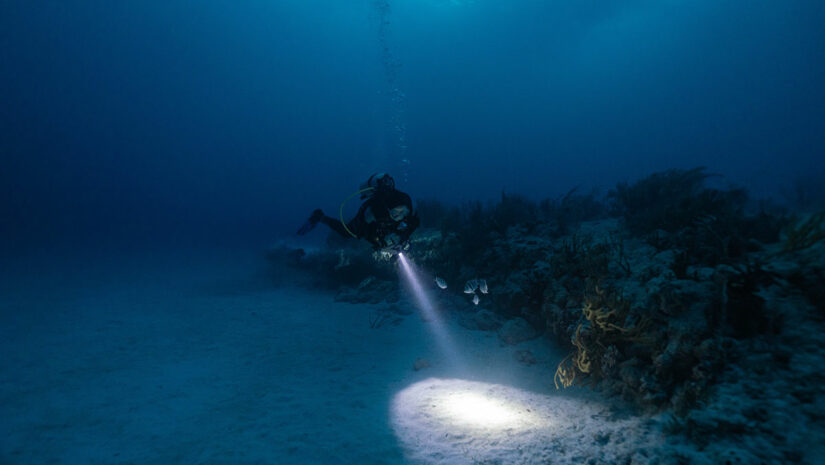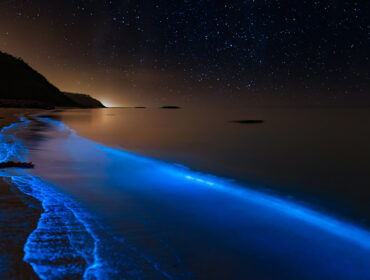Night diving is one of the best ways of seeing and experiencing your favorite dive sites in a whole new light. For those who have never tried it, the thought of descending into dark waters with only the beam of a dive flashlight for light may seem a little daunting and scary. But it need not be. That’s why we decided to put together all the information you would need the why, how, when and where, to prepare yourself and take that plunge into the darkness. Once you’ve logged a few, you’ll be looking forward to diving your favorite sites at night!
Why Dive at Night?
Scuba diving at night is a fascinating experience to say the least. Yes, the very limited visibility can keep you imagining what creatures lie outside your light beam, but the experience of weightlessly floating in complete darkness is the closest feeling you’ll get of being in space, right here on Earth. Talk about adventure! A whole new cast of characters comes alive after the sun goes down. From tiny Bioluminescent Plankton, to the fascinating phenomenon of coral fluorescence, these spectacles of nature can only be experience on a night dive.
Focused vision
You are more focused as your vision is limited to that of your light beam. Brighter colors and nocturnal creature you wouldn’t otherwise see, makes even a ten meter square more interesting; with a more to see than if you had seen it in the day and passed over it in a jiffy. Night diving is a completely different experience than diving during the day. It’s both exhilarating yet surprisingly calm and relaxing at the same time.
Brighter colors
Another appeal of night diving is the fact that colors appear brighter during the night. How is that you ask? As you remember from your basic scuba course, water absorbs color and the deeper you dive the less colorful the scenery. When you night dive however, you carry an underwater flashlight and since the beam doesn’t carry very far it’s not filtered as much as sunlight underwater, making fish and coral more vibrant and colorful in the artificial light.

What are the Different Types of Night Diving?
The most popular forms of night diving are:
- Dusk diving
- Cave diving
- Diving in very murky waters or waters with limited visibility
- Deep cliff or overhang diving
Many divers consider dusk diving to be the most relaxing form of nocturnal diving. Dusk divers begin their plunge during dusk, then slowly shift into complete darkness. Cave diving, as the name suggests, is the exploration of underwater cave systems.
Rules for Diving at Night
Night diving isn’t difficult, but it requires a divers to exercise a little extra caution and know some night diving safety rules. Here’s a few tips to night diving you should follow when you decide to take a plunge into dark waters.
Prepare your equipment
Set up all your scuba equipment in a well lit area preferably before you get on the boat and check your dive gear before especially your primary and back up dive lights.
Dive from a boat
Most divers do night dives from a dive boat as it makes entries and exits easier. You won’t have to deal with the surf or pay attention to where you’re wading (which are necessary when you’re shore diving).
Get to your dive site on time
Plan your dive properly so that you’ll reach your destination at around twilight. This time of day will give you enough light to help you prepare your gear for the dive and avoid blubbering in the dark. You can then enter the water knowing that you’ve got everything you need and your gear’s working when you’ve seen the sun set.
Take care of your dive flashlight
Keep your dive flashlight attached to your wrist at all times with a lanyard, and turn it on before entering the water. If you accidentally drop your light into the water, these rules will help you a lot since they’ll let you find your light by its beam.
Water can also enter your dive light when you turn it on or use its switches underwater, so you should avoid doing these things to keep your light working.
Dive with a buddy
Always dive with a dive buddy and stick close to each other throughout the dive. If you want you could use a short buddy line to reduce the risk of being separated, it’s not necessary but can be used especially if you’re very anxious about diving at night.
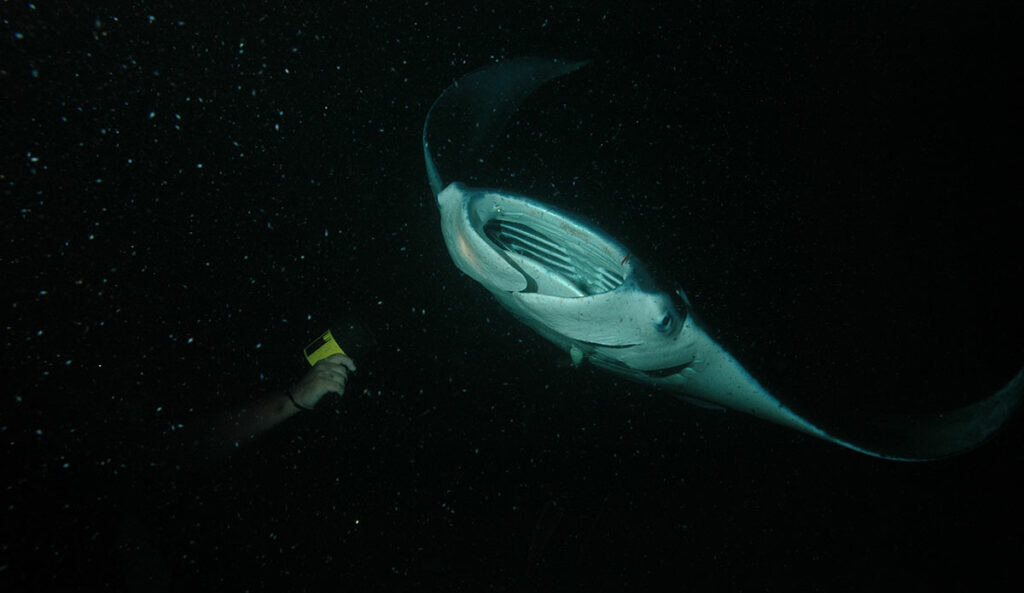
Never shine your light directly into another diver’s face
This tip is the golden rule for most night divers. If your light is aimed directly at your fellow diver’s eyes, it might make them temporarily blind. Also, keep your beam low to avoid bumping into any objects or kicking up sand that’s too close to the bottom.
Learn all night hand and dive light signals before your dive
Some examples of these signals include:
- Waving your torch back and forth horizontally in front of your buddy to catch their attention
- Waving your torch up and down to signal that there’s something wrong during your dive
- Waving your dive light in a circle to do the “OK” sign
Always remember that your bubbles go up
This tip is vital if you get disoriented during the dive or experience vertigo. In these cases, you should signal your buddy to help you get to the surface in a safe ascent. Breaking the surface and the sight of dive boat lights or starts will help make the side effects you’re experiencing subside.
Relax; don’t panic
As hard as it might be, you should curb your active imagination of what lurks beyond your dive light beam. If you’ve dived a lot in the day, you shouldn’t worry about bigger marine life and know that they might be more afraid of you than you are of them.
The best way of enjoying a night dive is to dive in slow motion and move in a calm and relaxed way. There are so many things to see even in that limited beam of light that you should take your time and go steady to get a nice close look at everything. Night dives can be very relaxing and just plain magnificent.
Keep an eye on your gauges
Pay attention to your air consumption and depth. It’s easy to go deep, considering you can’t see the bottom, especially if you’re diving a wall or a deeper dive site at night.
Don’t forget to look for bioluminescent organisms
Bioluminescent organisms glow a brilliant blue and green in the dark, just like stars do in the sky. You can see them by covering your dive torch’s beam with your hand or holding the light against your body to stop all light. Then, just wave your hand through the water, so you’ll see streams of tiny, bluish lights dance off your fingers.
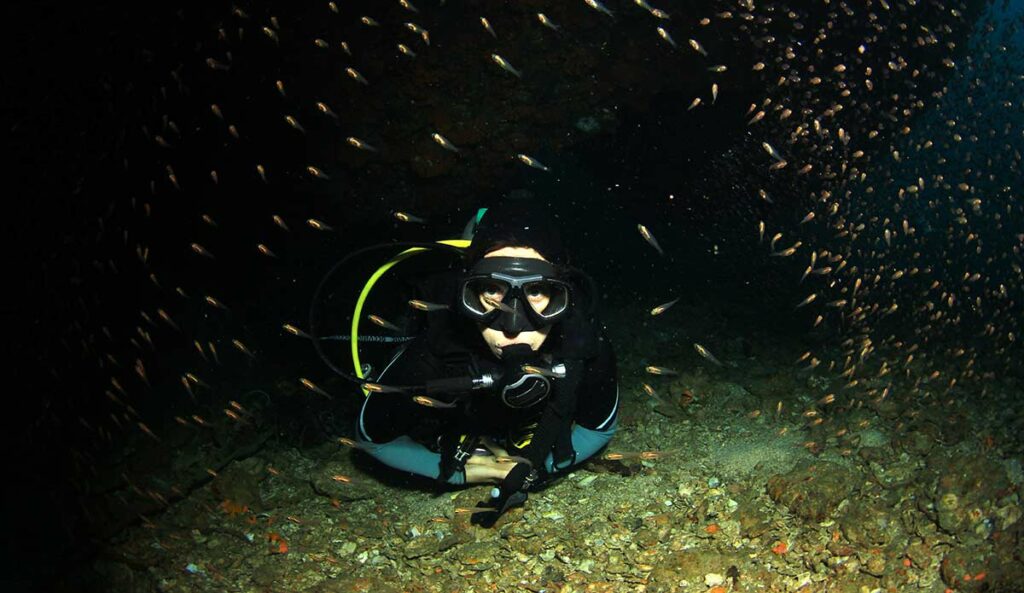
What are the Essential Pieces of Scuba Gear for Night Diving?
Dive light
The main piece of scuba diving gear you’ll need for diving after dark is a dive light or underwater torch. Diving lights are essential for seeing where you’re going underwater, and they’re a major means of communication at night.
Backup dive light
Well-equipped divers carry at least a primary and a secondary dive light with them, so it’s extremely important to bring a backup if your primary dive light fails. And as paranoid as it might seem, some divers even carry three or four backup lights to ensure that neither they nor their dive buddies have to end a dive without one.
Fortunately for consumers, the market gives you many options. Our guide to the best underwater flashlights can help you make an informed decision about your next purchase.
Safety & signaling gear
Carrying emergency signaling devices with you on night dives is also a must. If you surface away from a dive boat, these tools could help you get noticed in the dark. We recommend that you bring a combination of both visual and audible safety gear, which can consist of the following items:
- Whistles
- Strobe lights
- Air horns
- Glow-in-the-dark chemical light sticks (although experts recommend that you shouldn’t use them for marking since they’re not eco-friendly)
Scuba tank light
You’ll also need a scuba tank light (or a tank signal light) for a night dive. It lets you direct other divers to your location. Check out this article for more information on underwater signaling devices.
Protective gear
You should consider wearing the right protective gear if you’re night diving, as you risk bumping into things in the dark and getting cuts and scrapes. However, wearing gloves, boots, and other protective scuba gear doesn’t mean you should let your guard down. Pay attention to your surroundings to avoid colliding with fragile coral and marine life.
Other scuba diving equipment
While the rest of your personal scuba equipment for night diving does not differ much from day diving, there are a few considerations you can make.
If you or your dive buddy need an alternate air source, it should have a bright color so you can quickly identify and see it whenever there’s an emergency. You should also think about getting a hose protector in a vibrant shade for your spare octopus if it isn’t brightly colored. Bright hose protectors make your octopus stand out more in dark sites.
Plus, you should have illuminated scuba gauges or dive computers, or ones with bright markings for better visibility in the dark. Having a glow-in-the-dark dive slate to communicate on a night dive might also be a good idea.
A dive compass is another piece of gear that divers usually bring on night dives. This item helps you stay in place throughout your dive. Diving compasses come in a few configurations: you can attach them to your BCD, or strap them to your wrist. Some manufacturers even offer compasses that they’ve built into dive computers.
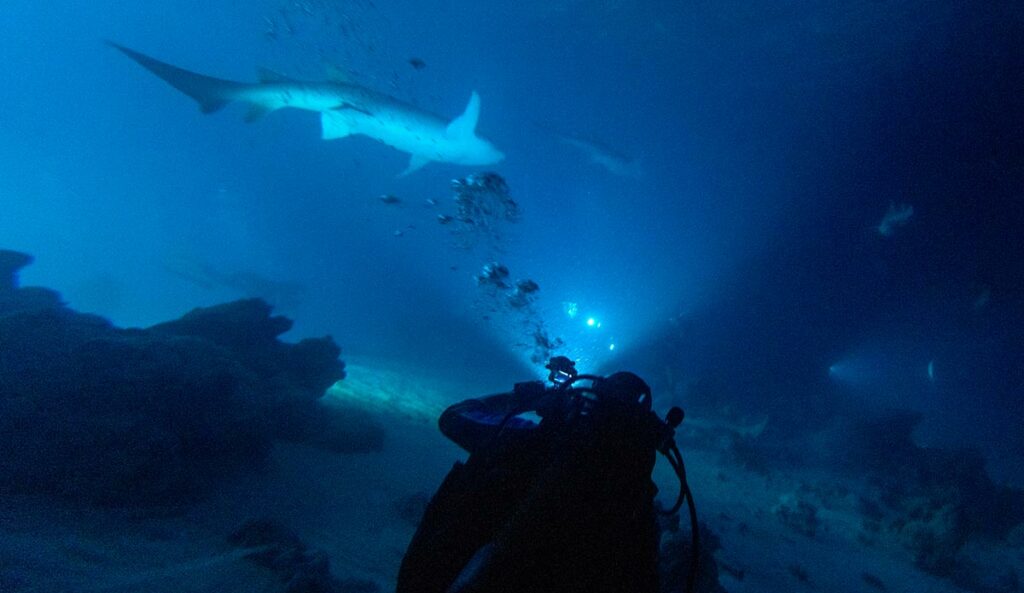
Best Places for Night Diving
Night diving offers a unique and captivating experience, revealing a whole new world of marine life that emerges under the cover of darkness. Here are some of the best places around the world to indulge in the wonders of night diving:
The Maldives
This tropical paradise is renowned for its vibrant coral reefs and abundant marine life. Under the cloak of night, the Maldives reveals a mesmerizing display of bioluminescent organisms, vibrant colors, and nocturnal creatures like nurse sharks, stingrays, and eels.
Palau
Palau‘s Jellyfish Lake becomes an otherworldly spectacle at night. Divers can witness the mesmerizing migration of millions of golden jellyfish as they swim towards the surface, glowing against the backdrop of a starry night sky.
Bonaire, Caribbean
Known as the “Divers’ Paradise,” Bonaire offers exceptional night diving opportunities. The calm and clear waters reveal an array of marine life, including octopuses, seahorses, and colorful reef fish. The abundant macro life makes it a favorite spot for underwater photographers.
Lembeh Strait, Indonesia
Dubbed the “Critter Capital of the World,” Lembeh Strait boasts a wealth of unique and bizarre marine creatures. Night dives here unveil a fascinating array of rare and elusive species, such as frogfish, mandarinfish, and ghost pipefish.
Great Barrier Reef, Australia
The world’s largest coral reef system, the Great Barrier Reef, offers spectacular night diving experiences. Divers can witness the mesmerizing display of bioluminescent organisms, vibrant corals, and encounter turtles, reef sharks, and giant clams.
Red Sea, Egypt
The Red Sea is a diver’s paradise, and night diving adds an extra dimension to its allure. With warm waters, excellent visibility, and a rich diversity of marine life, divers can encounter vibrant coral gardens, schools of barracudas, and even the occasional encounter with dolphins or dugongs.
Socorro Islands, Mexico
This remote archipelago in the Pacific Ocean is known for its encounters with large marine creatures. At night, divers can witness manta rays gliding through the water, as well as encounters with bottlenose dolphins, humpback whales (during the migration season), and the occasional sighting of a whale shark.
Malapascua Island, Philippines
Malapascua Island is famous for its thresher shark encounters, but night diving here is equally enchanting. Divers can witness the unique mating dance of mandarinfish, encounter flamboyant cuttlefish, and marvel at the colorful display of critters on the sandy slopes.
Silfra Fissure, Iceland
For a truly otherworldly night diving experience, Silfra Fissure in Iceland offers crystal-clear waters and breathtaking underwater landscapes. Diving between the Eurasian and North American tectonic plates provides a surreal sensation, and the opportunity to witness the Northern Lights from underwater is simply unforgettable.
Coco Island, Costa Rica
Coco Island is a remote and untouched paradise renowned for its pristine waters and abundant marine life. Night dives here offer the chance to encounter hammerhead sharks, eagle rays, and large schools of jacks, surrounded by the beauty of an untouched marine ecosystem.
Remember, before embarking on a night diving adventure, ensure you have the necessary certifications, experience, and dive with a reputable operator. Always prioritize safety and follow proper diving procedures to fully enjoy the magical world that awaits beneath the surface after the sun goes down.
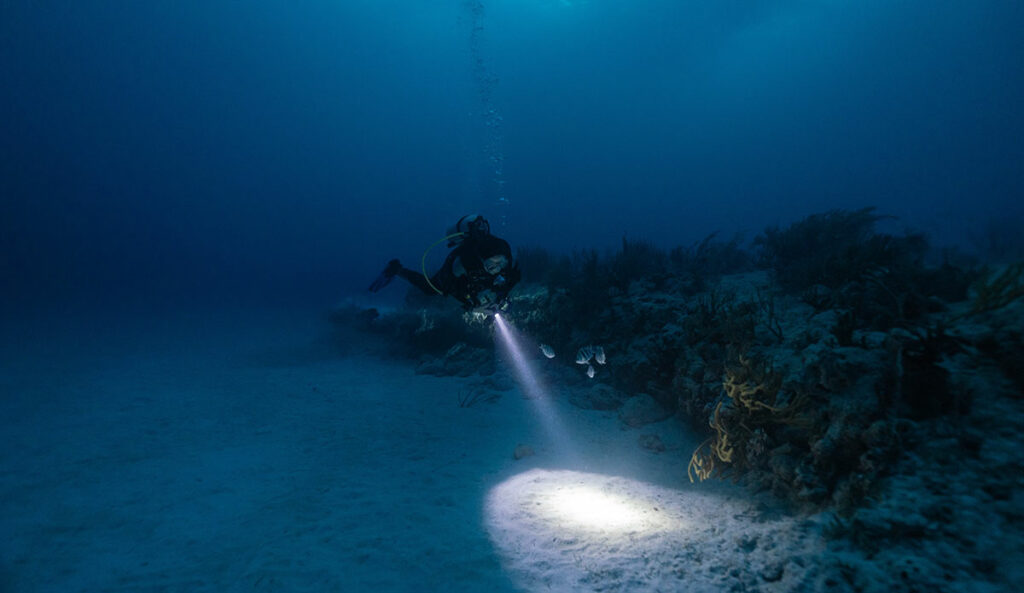
Night Diving: Frequently Asked Questions
Yes. Always remember that you should dive at night with a dive buddy you feel comfortable with. It’s important that you stick close to each other to avoid dive buddy separation. If you want, you could use a short buddy line to reduce the risk of separation, especially if you’re very anxious about diving at night.
Night dives can be safe when conducted with proper training, equipment, and adherence to established protocols. Divers should have experience and knowledge of the dive site, use reliable lights, and stay close to their buddy. Proper planning, communication, and caution are essential to ensure a safe and enjoyable night diving experience.
Night diving can vary in depth depending on the dive site and the comfort level of the divers. It can range from shallow dives of 10-15 feet (3-5 meters) for beginners to deeper dives of 60-80 feet (18-24 meters) for more experienced divers. Depth should always be chosen based on individual skill and safety considerations.

